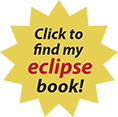How to View the Sun Safely
It’s simple! Look at the pictures (and read the captions) on the left side of this page.
Or, just follow these rules:
1. Look at the Sun ONLY through an approved filter. See a list of what not to use here.
2. Inspect the filter before you use it. Look for pinholes, tears, cracks, separation of the filter material from its holder, or anything else you judge as a problem. If you find anything wrong, do not use the filter AND throw it away so nobody else will use it.
3. Take a few seconds to look through the filter at earthly objects. You should not see anything through the filter.
4. If the filter is one you hold, move it close to your eyes before you look at the Sun. If the filter is one you wear (glasses), put them on before you look at the Sun.
5. Making sure the filter or glasses stay close to your eyes, find the Sun and observe!
6. Never look through binoculars, a telescope, or any other optical device while you are wearing (or holding) a solar filter. The concentrated sunlight can burn through the filter and severely damage your eyes.
Why is it Unsafe to Look at the Sun?
“Don’t look at the Sun” is a rule every human being follows from the time they’re old enough to understand what it means. We know, instinctively, that it’s unsafe to gaze at our daytime star, even if few of us understand why. Ask someone, and you’ll probably hear, “It’s too bright!” But that’s not correct. In fact, we have the Sun’s overwhelming brilliance to thank for keeping humans from looking at it. The real reason the Sun is unsafe to look at goes far beyond what we can see.
We broadly define sunlight as “white” light, and that’s a pretty good description. The Sun’s white light combines all the colors in the rainbow. Remember the mnemonic name “Roy G. Biv”? The letters stand for red, orange, yellow, green, blue, indigo, and violet. Red light has the longest wavelength, and violet light has the shortest. But light isn’t the only radiation the Sun emits.
Invisible wavelengths exist beyond both the red and violet ends of the visible spectrum. Scientists call longer wavelengths than red “infrared,” and most people know them by their much more common name: heat. The radiation beyond the violet end is “ultraviolet,” and it’s really dangerous to your eyes. Ultraviolet rays suntan our skin, so you can imagine the damage they would do to unfiltered eyes.
An approved solar filter completely blocks infrared and ultraviolet radiation. It also reduces the Sun’s brightness to a level that you can look at the Sun without squinting.”
When Can You Look at the Sun Without a Filter?
After all the warnings and careful explanations, there is, actually, one time when you can look directly at the Sun. It’s during the total phase of a solar eclipse. Not during a partial eclipse. Not during the partial phases of a total eclipse. Only during totality. In fact, if you don’t remove the filter from in front of your eyes, you will miss the glory of the total part of the eclipse altogether.
If you live in the U.S. and do not travel to see any other total solar eclipses, in the time span between March 2015 and April 2024, you can look directly at the Sun for a maximum of 2 minutes and 41 seconds. That’s it. After that event, the next safe time to look at the Sun will be when the U.S. experiences its next total solar eclipse, April 8, 2024. But we’ll save that discussion until after 2017.

